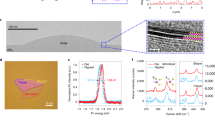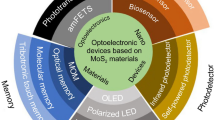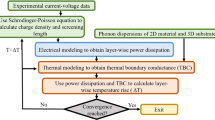Abstract
Since the first report of promising electrical properties of Molybdenum disulfide (MoS2) transistors in 2011, two-dimensional materials with unique properties have attracted great attention, and much research on their applications has been carried out. MoS2 and black phosphorus are excellent candidates for advanced applications in future electronics because of their tunable bandgap, high carrier mobility, and ultra-thin bodies. In this review, recent research trends in the application of molybdenum disulfide and black phosphorus to electronic devices are examined. We mainly address mobility improvements, dielectrics engineering, radio frequency applications, and low-frequency noise, all of which are crucial for the development of electronic and optoelectronic devices.
创新点
自从2011年基于单层硫化钼的晶体管成功制备开始,基于二维层状材料沟道的电子器件一直是国际学术界和工业界广泛关注的前沿热点,主要原因有两点:1.二维材料超薄体效应可以最大程度地抑制晶体管中的短沟道效应,在极限器件尺寸下,二维材料晶体管性能将有望超越硅基器件。2.二维材料具有高迁移率、能带可调控、各向异性等特点。本文介绍了近几年二硫化钼和黒磷的研究进展, 主要包括迁移率、高频器件、及低频噪声等方面的内容。
Similar content being viewed by others
References
Xuan Y, Wu Y Q, Ye P D. High-performance inversion-type enhancement-mode InGaAs MOSFET with maximum drain current exceeding 1 A/mm. IEEE Electron Dev Lett, 2008, 29: 294–296
Del Alamo J A. Nanometre-scale electronics with III-V compound semiconductors. Nature, 2011, 479: 317–323
Zhang R, Huang P C, Lin J C, et al. High-mobility Ge p-and n-MOSFETs with 0.7-nm EOT using HfO2/Al2O3/GeOx/Ge gate stacks fabricated by plasma postoxidation. IEEE Trans Electron Dev, 2013, 60: 927–934
Wu H, Si M W, Dong L, et al. Germanium nMOSFETs with recessed channel and S/D: contact, scalability, interface, and drain current exceeding 1 A/mm. IEEE Trans Electron Dev, 2015, 62: 1419–1426
Schwierz F. Graphene transistors. Nat Nanotechnol, 2010, 5: 487–496
Novoselov K S, Geim A K, Morozov S V, et al. Electric field effect in atomically thin carbon films. Science, 2004, 306: 666–669
Geim A K, Novoselov K S. The rise of graphene. Nat Mater, 2007, 6: 183–191
Koski K J, Cui Y. The new skinny in two-dimensional nanomaterials. ACS Nano, 2013, 7: 3739–3743
Miro P, Audiffred M, Heine T. An atlas of two-dimensional materials. Chem Soc Rev, 2014, 43: 6537–6554
Chhowalla M, Shin H S, Eda G, et al. The chemistry of two-dimensional layered transition metal dichalcogenide nanosheets. Nat Chem, 2013, 5: 263–275
Radisavljevic B, Radenovic A, Brivio J, et al. Single-layer MoS2 transistors. Nat Nanotechnol, 2011, 6: 147–150
Wang Q H, Kalantar-Zadeh K, Kis A, et al. Electronics and optoelectronics of two-dimensional transition metal dichalcogenides. Nat Nanotechnol, 2012, 7: 699–712
Butler S Z, Hollen S M, Cao L, et al. Progress, challenges, and opportunities in two-dimensional materials beyond graphene. ACS Nano, 2013, 7: 2898–2926
Ganatra R, Zhang Q. Few-Layer MoS2: a promising layered semiconductor. ACS Nano, 2014, 8: 4074–4099
Li L K, Yu Y J, Ye G J, et al. Black phosphorus field-effect transistors. Nat Nanotechnol, 2014, 9: 372–377
Liu H, Neal A T, Zhu Z, et al. Phosphorene: an unexplored 2D semiconductor with a high hole mobility. ACS Nano, 2014, 8: 4033–4041
Du H W, Lin X, Xu Z M, et al. Recent developments in black phosphorus transistors. J Mater Chem C, 2015, 3: 8760–8775
Tran V, Soklaski R, Liang Y, et al. Layer-controlled band gap and anisotropic excitons in few-layer black phosphorus. Phys Rev B, 2014, 89: 235319
Ling X, Wang H, Huang S X, et al. The renaissance of black phosphorus. Proc Natl Acad Sci, 2015, 112: 4523–4530
Santos E J G, Kaxiras E. Electric-field dependence of the effective dielectric constant in graphene. Nano Lett, 2013, 13: 898–902
Mak K F, Lee C, Hone J, et al. Atomically thin MoS2: a new direct-gap semiconductor. Phys Rev Lett, 2010, 105: 136805
Fiori G, Bonaccorso F, Iannaccone G, et al. Electronics based on two-dimensional materials. Nat Nanotechnol, 2014, 9: 768–779
Jariwala D, Sangwan V K, Lauhon L J, et al. Emerging device applications for semiconducting two-dimensional transition metal dichalcogenides. ACS Nano, 2014, 8: 1102–1120
Schwierz F, Pezoldt J, Granzner R. Two-dimensional materials and their prospects in transistor electronics. Nanoscale, 2015, 7: 8261–8283
Yazyev O V, Kis A. MoS2 and semiconductors in the flatland. Mater Today, 2015, 18: 20–30
Lopez-Sanchez O, Lembke D, Kayci M, et al. Ultrasensitive photodetectors based on monolayer MoS2. Nat Nanotechnol, 2013, 8: 497–501
Radisavljevic B, Whitwick M B, Kis A. Integrated circuits and logic operations based on single-layer MoS2. ACS Nano, 2011, 5: 9934–9938
Late D J, Huang Y-K, Liu B, et al. Sensing behavior of atomically thin-layered MoS2 transistors. ACS Nano, 2013, 7: 4879–4891
Liu H, Neal A T, Ye P D. Channel length scaling of MoS2 MOSFETs. ACS Nano, 2012, 6: 8563–8569
Du Y C, Yang L M, Liu H, et al. Contact research strategy for emerging molybdenum disulfide and other twodimensional field-effect transistors. APL Mater, 2014, 2: 092510
Liu D, Guo Y, Fang L, et al. Sulfur vacancies in monolayer MoS2 and its electrical contacts. Appl Phys Lett, 2013
Das S, Chen H-Y, Penumatcha A V, et al. High performance multilayer MoS2 transistors with scandium contacts. Nano Lett, 2012, 13: 100–105
Novoselov K S, Jiang D, Schedin F, et al. Two-dimensional atomic crystals. Proc Nat Acad Sci, 2005, 102: 10451–10453
Radisavljevic B, Kis A. Mobility engineering and a metal–insulator transition in monolayer MoS2. Nat Mater, 2013, 12: 815–820
Kaasbjerg K, Thygesen K S, Jacobsen KW. Phonon-limited mobility in n-type single-layer MoS2 from first principles. Physl Rev B, 2012, 85: 115317
Kaasbjerg K, Thygesen K S, Jauho A-P. Acoustic phonon limited mobility in two-dimensional semiconductors: deformation potential and piezoelectric scattering in monolayer MoS2 from first principles. Phys Rev B, 2013, 87: 235312
Jariwala D, Sangwan V K, Late D J, et al. Band-like transport in high mobility unencapsulated single-layer MoS2 transistors. Appl Phys Lett, 2013, 102: 173107
Baugher B W H, Churchill H O H, Yang Y F, et al. Intrinsic electronic transport properties of high-quality monolayer and bilayer MoS2. Nano Lett, 2013, 13: 4212–4216
Jena D, Konar A. Enhancement of carrier mobility in semiconductor nanostructures by dielectric engineering. Phys Rev Lett, 2007, 98: 136805
Ma N, Jena D. Charge scattering and mobility in atomically thin semiconductors. Phys Rev X, 2014, 4: 011043
Zeng L, Xin Z, Chen S W, et al. Remote phonon and impurity screening effect of substrate and gate dielectric on electron dynamics in single layer MoS2. Appl Phys Lett, 2013, 103: 113505
Singh A K, Hennig R G, Davydov A V, et al. Al2O3 as a suitable substrate and a dielectric layer for n-layer MoS2. Appl Phys Lett, 2015, 107: 053106
Ong Z-Y, Fischetti M V. Mobility enhancement and temperature dependence in top-gated single-layer MoS2. Physl Rev B, 2013, 88: 165316
Bao W Z, Cai X H, Kim D, et al. High mobility ambipolar MoS2 field-effect transistors: substrate and dielectric effects. Appl Phys Lett, 2013, 102: 042104
Dean C, Young A, Meric I, et al. Boron nitride substrates for high-quality graphene electronics. Nat Nanotechnol, 2010, 5: 722–726
Cui X, Lee G-H, Kim Y D, et al. Multi-terminal transport measurements of MoS2 using a van der Waals heterostructure device platform. Nat Nanotechnol, 2015, 10: 534–540
Yoon Y, Ganapathi K, Salahuddin S. How good can monolayer MoS2 transistors be? Nano Lett, 2011, 11: 3768–3773
Alam K, Lake R K. Monolayer MoS2 transistors beyond the technology road map. IEEE Trans Electron Dev, 2012, 59: 3250–3254
Liu F, Wang Y, Liu X, et al. A theoretical investigation of orientation dependent transport in monolayer MoS2 transistors at the ballistic limit. IEEE Electron Dev Lett, 2015, 36: 1091–1093
Liu L T, Lu Y, Guo J. On monolayer MoS2 field-effect transistors at the scaling limit. IEEE Trans Electron Dev, 2013, 60: 4133–4139
Chang J, Register L F, Banerjee S K. Atomistic full-band simulations of monolayer MoS2 transistors. Appl Phys Lett, 2013, 103: 223509
Yang L M, Majumdar K, Du Y C, et al. High-performance MoS2 field-effect transistors enabled by chloride doping: record low contact resistance (0.5 kohm* µm) and record high drain current (460 µA/µm). In: Proceedings of 2014 Symposium on VLSI Technology: Digest of Technical Papers, Honolulu, 2014. 192–193
Li X F, Yang L M, Si M W, et al. Performance potential and limit of MoS2 transistors. Adv Mater, 2015, 27: 1547–1552
Wu Y Q, Farmer D B, Xia F N, et al. Graphene electronics: materials, devices, and circuits. Proc IEEE, 2013, 101: 1620–1637
Wu Y Q, Lin Y-m, Bol A A, et al. High-frequency, scaled graphene transistors on diamond-like carbon. Nature, 2011, 472: 74–78
Wu Y Q, Jenkins K A, Valdes-Garcia A, et al. State-of-the-art graphene high-frequency electronics. Nano Lett, 2012, 12: 3062–3067
Wang H, Yu L L, Lee Y-H, et al. Large-scale 2D electronics based on single-layer MoS2 grown by chemical vapor deposition. In: Proceedings of the 2012 International Electron Devices Meeting, San Francisco, 2012. 4.6.1–4.6.4
Krasnozhon D, Lembke D, Nyffeler C, et al. MoS2 transistors operating at gigahertz frequencies. Nano Lett, 2014, 14: 5905–5911
Cheng R, Jiang S, Chen Y, et al. Few-layer molybdenum disulfide transistors and circuits for high-speed flexible electronics. Nat Commun, 2014, 5: 5143
Sanne A, Ghosh R, Rai A, et al. Radio frequency transistors and circuits based on CVD MoS2. Nano Lett, 2015, 15: 5039–5045
Hooge F. 1/f noise sources. IEEE Trans Electron Dev, 1994, 41: 1926–1935
Von Haartman M, Mikael S. Low-frequency Noise in Advanced MOS Devices. Berlin: Springer, 2007
Razavi B. A study of phase noise in CMOS oscillators. IEEE J Solid-State Circ, 1996, 31: 331–343
Sangwan V K, Arnold H N, Jariwala D, et al. Low-frequency electronic noise in single-layer MoS2 transistors. Nano Lett, 2013, 13: 4351–4355
Kwon H-J, Kang H, Jang J, et al. Analysis of flicker noise in two-dimensional multilayer MoS2 transistors. Appl Phys Lett, 2014, 104: 083110
Renteria J, Samnakay R, Rumyantsev S L, et al. Low-frequency 1/f noise in MoS2 transistors: relative contributions of the channel and contacts. Appl Phys Lett, 2014, 104: 153104
Rumyantsev S L, Jiang C L, Samnakay R, et al. 1/f noise characteristics of MoS2 thin-film transistors: comparison of single and multilayer structures. IEEE Electron Dev Lett, 2015, 36: 517–519
Keyes R W. The electrical properties of black phosphorus. Phys Rev, 1953, 92: 580–584
Morita A. Semiconducting black phosphorus. Appl Phys A, 1986, 39: 227–242
Buscema M, Groenendijk D J, Blanter S I, et al. Fast and broadband photoresponse of few-layer black phosphorus field-effect transistors. Nano Lett, 2014, 14: 3347–3352
Buscema M, Groenendijk D J, Steele G A, et al. Photovoltaic effect in few-layer black phosphorus PN junctions defined by local electrostatic gating. Nat Commun, 2014, 5: 4651
Zhu W N, Yogeesh M N, Yang S X, et al. Flexible black phosphorus ambipolar transistors, circuits and AM demodulator. Nano Lett, 2015, 15: 1883–1890
Fei R X, Yang L. Strain-engineering the anisotropic electrical conductance of few-layer black phosphorus. Nano Lett, 2014, 14: 2884–2889
Hong T, Chamlagain B, Lin W Z, et al. Polarized photocurrent response in black phosphorus field-effect transistors. Nanoscale, 2014, 6: 8978–8983
Ong Z-Y, Cai Y Q, Zhang G, et al. Strong thermal transport anisotropy and strain modulation in single-layer phosphorene. J Phys Chem C, 2014, 118: 25272–25277
Ong Z-Y, Zhang G, Zhang Y W. Anisotropic charged impurity-limited carrier mobility in monolayer phosphorene. J Appl Phys, 2014, 116: 214505
Qiao J S, Kong X H, Hu Z-X, et al. High-mobility transport anisotropy and linear dichroism in few-layer black phosphorus. Nat Commun, 2014, 5: 4475
Ge S F, Li C K, Zhang Z M, et al. Dynamical evolution of anisotropic response in black phosphorus under ultrafast photoexcitation. Nano Lett, 2015, 15: 4650–4656
Jiang J-W. Thermal conduction in single-layer black phosphorus: highly anisotropic? Nanotechnology, 2015, 26: 055701
Lu W L, Ma X M, Fei Z, et al. Probing the anisotropic behaviors of black phosphorus by transmission electron microscopy, angular-dependent Raman spectra, and electronic transport measurements. Appl Phys Lett, 2015, 107: 021906
Wang X M, Jones A M, Seyler K L, et al. Highly anisotropic and robust excitons in monolayer black phosphorus. Nat Nanotechnol, 2015, 10: 517–521
Xia F N, Wang H, Jia Y C. Rediscovering black phosphorus as an anisotropic layered material for optoelectronics and electronics. Nat Commun, 2014, 5: 4458
Du Y C, Liu H, Deng Y X, et al. Device perspective for black phosphorus field-effect transistors: contact resistance, ambipolar behavior, and scaling. ACS Nano, 2014, 8: 10035–10042
Haratipour N, Robbins M C, Koester S J. Black phosphorus p-MOSFETs with 7-nm HfO2 gate dielectric and low contact resistance. IEEE Electron Dev Lett, 2015, 36: 411–413
Das S, Demarteau M, Roelofs A. Ambipolar phosphorene field effect transistor. ACS Nano, 2014, 8: 11730–11738
Perello D J, Chae S H, Song S, et al. High-performance n-type black phosphorus transistors with type control via thickness and contact-metal engineering. Nat Commun, 2015, 6: 7809
Liu H, Neal A T, Si M W, et al. The effect of dielectric capping on few-layer phosphorene transistors: tuning the schottky barrier heights. IEEE Electron Dev Lett, 2014, 35: 795–797
Padilha J E, Fazzio A, da Silva A J R. van der Waals heterostructure of phosphorene and graphene: tuning the schottky barrier and doping by electrostatic gating. Phys Rev Lett, 2015, 114: 066803
Kamalakar M V, Madhushankar B N, Dankert A, et al. Low schottky barrier black phosphorus field-effect devices with ferromagnetic tunnel contacts. Small, 2015, 11: 2209–2216
Joshua O I, Gary A S, Herre S J V D Z, et al. Environmental instability of few-layer black phosphorus. 2D Mater, 2015, 2: 011002
Wood J D, Wells S A, Jariwala D, et al. Effective passivation of exfoliated black phosphorus transistors against ambient degradation. Nano Lett, 2014, 14: 6964–6970
Boukhvalov D W, Rudenko A N, Prishchenko D A, et al. Chemical modifications and stability of phosphorene with impurities: a first principles study. Phys Chem Chem Phys, 2015, 17: 15209–15217
Wang Z H, Islam A, Yang R, et al. Environmental, thermal, and electrical susceptibility of black phosphorus field effect transistors. J Vac Sci Technol B, 2015, 33: 052202
Saito Y, Iwasa Y. Ambipolar insulator-to-metal transition in black phosphorus by ionic-liquid gating. ACS Nano, 2015, 9: 3192–3198
Kim J-S, Liu Y N, Zhu W N, et al. Toward air-stable multilayer phosphorene thin-films and transistors. Sci Rep, 2015, 5: 8989
Favron A, Gaufres E, Fossard F, et al. Photooxidation and quantum confinement effects in exfoliated black phosphorus. Nat Mater, 2015, 14: 826–832
Ziletti A, Carvalho A, Campbell D K, et al. Oxygen defects in phosphorene. Phys Rev Lett, 2015, 114: 046801
Zhu H, McDonnell S, Qin X Y, et al. Al2O3 on black phosphorus by atomic layer deposition: an in situ interface study. ACS Appl Mater Interface, 2015, 7: 13038–13043
Cai Y Q, Zhang G, Zhang Y-W. Electronic properties of phosphorene/graphene and phosphorene/hexagonal boron nitride heterostructures. J Phys Chem C, 2015, 119: 13929–13936
Chen X L, Wu Y Y, Wu Z F, et al. High-quality sandwiched black phosphorus heterostructure and its quantum oscillations. Nat Commun, 2015, 6: 7315
Doganov R A, Koenig S P, Yeo Y, et al. Transport properties of ultrathin black phosphorus on hexagonal boron nitride. Appl Phys Lett, 2015, 106: 083505
Doganov R A, O’Farrell E C T, Koenig S P, et al. Transport properties of pristine few-layer black phosphorus by van der Waals passivation in an inert atmosphere. Nat Commun, 2015, 6: 6647
Gillgren N, Wickramaratne D, Shi Y M, et al. Gate tunable quantum oscillations in air-stable and high mobility few-layer phosphorene heterostructures. 2D Mater, 2015, 2: 011001
Li L K, Ye G J, Tran V, et al. Quantum oscillations in a two-dimensional electron gas in black phosphorus thin films. Nat Nanotechnol, 2015, 10: 608–613
Tayari V, Hemsworth N, Fakih I, et al. Two-dimensional magnetotransport in a black phosphorus naked quantum well. Nat Commun, 2015, 6: 7702
Yasaei P, Kumar B, Foroozan T, et al. High-quality black phosphorus atomic layers by liquid-phase exfoliation. Adv Mater, 2015, 27: 1887–1892
Kang J, Wood J D, Wells S A, et al. Solvent exfoliation of electronic-grade, two-dimensional black phosphorus. ACS Nano, 2015, 9: 3596–3604
Yang Z B, Hao J H, Yuan S G, et al. Field-effect transistors based on amorphous black phosphorus ultrathin films by pulsed laser deposition. Adv Mater, 2015, 27: 3748–3754
Li X S, Deng B C, Wang X M, et al. Synthesis of thin-film black phosphorus on a flexible substrate. 2D Mater, 2015, 2: 031002
Wang H, Wang X M, Xia F N, et al. Black phosphorus radio-frequency transistors. Nano Lett, 2014, 14: 6424–6429
Vandamme L, Li X S, Rigaud D. 1/f noise in MOS devices, mobility or number fluctuations? IEEE Trans Electron Dev, 1994, 41: 1936–1945
Na J H, Lee Y T, Lim J A, et al. Few-layer black phosphorus field-effect transistors with reduced current fluctuation. ACS Nano, 2014, 8: 11753–11762
Li X F, Du Y C, Si M W, et al. Mechanisms of current fluctuation in ambipolar black phosphorus field-effect transistors. Nanoscale, 2016, 8: 3572–3578
Author information
Authors and Affiliations
Corresponding author
Rights and permissions
About this article
Cite this article
Li, X., Gao, T. & Wu, Y. Development of two-dimensional materials for electronic applications. Sci. China Inf. Sci. 59, 061405 (2016). https://doi.org/10.1007/s11432-016-5559-z
Received:
Accepted:
Published:
DOI: https://doi.org/10.1007/s11432-016-5559-z




